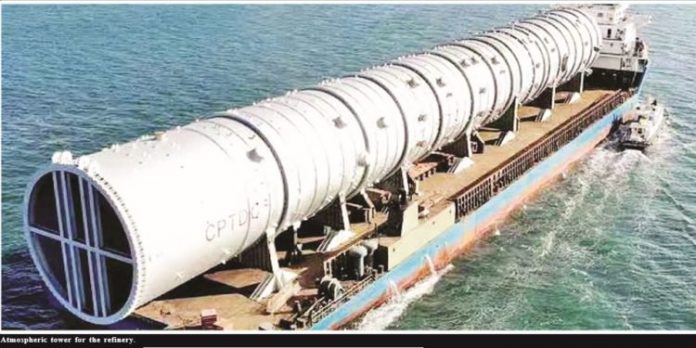Many are waiting to see the effect the massive Dangote refinery will have on the economy and job creation. But they have to wait until the end of next year, according to this report by Reuters and Our Reporter.
AFRICA’s largest oil refinery will not be finished until the end of 2020 due to problems importing steel and other equipment, executives at Dangote, which is building the facility in the Nigerian commercial hub of Lagos, told Reuters.
Nigeria, Africa’s most populous nation, imports virtually all its fuel due to sclerotic and underutilised refineries, and even the state oil company is looking to the 650,000 barrel per day (bpd) Dangote refinery to help address this.
Price caps force NNPC to import nearly all its gasoline at a significant cost and periodic fuel shortages are common.
Despite the delays at the congested Apapa and Tin Can Island Ports in Lagos, a Dangote executive said the company could start using the refinery’s tank farms as a depot to warm-up operations.
“We will be able to complete the (refinery) project by the end of next year – mechanical completion,” said Dangote Group Executive Director Devakumar Edwin, who oversees the project.
The company expects fuel production within two months of completion of the refinery, which could transform Africa’s biggest crude producer from a fuel importer into a net exporter, upending global trade patterns.

Billionaire Aliko Dangote, who built his fortune on cement, first announced a smaller refinery in 2013, to be finished in 2016. Dangote then moved the site to Lekki, in Lagos, upgraded the size and said production would start in early 2020.
Industry sources told Reuters last year that fuel output was unlikely before 2022.
Trading plan
Edwin also said during an interview at his office in Lagos that Dangote is setting up its trading desk, with a senior team of three people and a staff of roughly 30 who will monitor international commodity prices.
“We are setting up a complete trading desk here with us. In the next three months the full desk will be set up,” he said.
Giuseppe Surace, the refinery’s chief operations officer, said the refinery’s tank farms will be finished this year and could be used as a warm-up for operations.
The tanks will be connected to five “single point mooring buoys” (SPMs), which will allow the refinery complex to pump crude straight into tanks from large ships at sea and pump products back out onto boats of any size.
The SPMs will be the primary method of supplying oil products from the refinery, Surace said, adding that the team were considering using the tanks as training or as a depot before the refinery’s production starts.
“We might do that. We will be ready to do that,” he said, though he added that no decision had been taken yet.
The team is in talks with NNPC, two other international oil companies and two large oil traders, all of whom are interested in supplying crude and buying products, Edwin said.
Edwin said the crude unit for the refinery, which set sail from China last month, would arrive by the end of October.
The trains at a fertilizer plant on the same site will start up by the end of this year, the executives said.
The planned products to be produced at the refinery
The planned annual products of the refinery include 10.4 million tonnes of gasoline, 4.6 million tonnes of diesel and 4 million tonnes of jet fuel. Others to be produced annually are 0.6 million tonnes of polypropylene, 0.5 million tonnes of carbon black feed, 0.24 million tonnes of propane and 32,000 tonnes of sulphur.
According to the owner of the refinery, Aliko Dangote, the enormous project will cost between Us $12m and Us $14m. Facilities at the Refinery Complex, the building and shipment of the atmospheric tower are indeed considered a major and significant feat; yet there are other units of the refinery left to be sourced. Among the units to occupy the refinery and petrochemical complex are mild hydrocracking (MHC) unit, residual fluid catalytic cracking (RFCC), naphtha hydrotreater, RFCC gasoline hydrodesulfurisation (HDS) unit and alkylation units, and others.
The refinery complex will also possess infrastructural facilities like access roads, administrative building, pipeline system and tank storage facilities, among others. Importantly, the facility will have a fertiliser plant to be served by the refinery by-products as raw materials. Conclusion The atmospheric tower is supposed to be a piece of major equipment at the Dangote Refinery and Petrochemical Complex. It is expected to process crude oil into fuels including gasoline and diesel.
World’s largest atmospheric tower
On July 29, the atmospheric tower, a piece of equipment that will process crude oil for the refinery set sail from Sinopec Corporation’s factory in China.
“On July 29, the world’s largest atmospheric tower built by Sinopec slowly left a wharf in Ningbo. Following the Maritime #SilkRoad, it will travel to #Nigeria and be installed at the world’s biggest single-train facility – Nigeria’s Dangote Refinery,” Sinopec said in a tweet.
The atmospheric tower has a diameter of 12 meters, a length of 112.56 meters and a unit weight of 2252 tons.
“It is the largest diameter, longest length and the heaviest single-unit equipment in domestic export equipment. It will be installed in the world’s largest single-series refinery – the 32.5 million tonnes/year Dangote refinery in Nigeria,” the Chinese firm said in a statement on its website.
The atmospheric tower is the primary unit processing crude oil into fuels, according to a Citac analyst, Jeremy Parker.
“This is a major milestone, but there is still much work to be done, both in terms of sourcing the other units and interconnection at the site,” Parker said of the atmospheric tower shipment.
Dangote Industries has awarded not less than $368m worth of contracts to 120 local contractors for the refinery and petrochemical project to help local content development initiative.
Edwin noted that the refinery would lead to significant skills transfer and technology acquisition opportunities in the country, adding that the refinery could meet the country’s requirement of all liquid products, such as petrol, diesel, kerosene and aviation fuel, and would have a surplus of each of the products for export.


